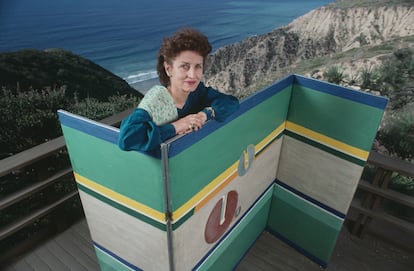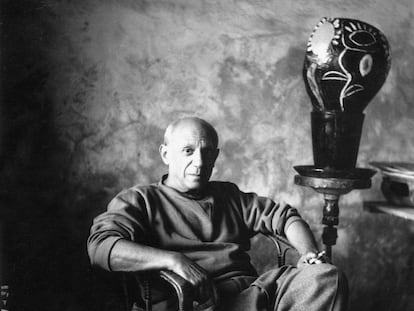Françoise Gilot or the need to contradict destiny
It must not have been easy, not simply to survive Picasso, but to forge ahead with her own artistic project, which she’d had clear ideas about since her arrival in Paris


“On the rue des Grand-Augustins, I run into Françoise Gilot. As always, she is carrying large rolls of paper under her arm and, despite the cold and cutting northern wind, she unfolds some new gouaches, mostly still lifes of bright colors, revealing an undeniable talent for painting. ‘I am going to show them to Picasso,’ she tells me with a complicit smile,” writes Brassaï in his 1964 book Conversations with Picasso.
The day of the meeting was Tuesday, December 7, 1943, and Françoise Gilot was then ―as Brassaï tells it― a young woman gifted for art who was eager to receive advice but also to show what she was capable of doing, and aware that the Hungarian photographer’s keen eye would appreciate her talent even with this quick glance on a Parisian street. Françoise Gilot, who died last Tuesday at the age of 101, was a fine artist. And she was above all vital ― one of those people capable of looking ahead, of setting goals and pursuing them, although in the Paris of 1943 ―and even in New York, judging by the few women in abstract expressionism ― pursuing goals and contradicting fate cannot have been an easy target for a woman born into a comme-il-faut family.
Like Louise Bourgeois, another great French artist who flourished in the United States, Gilot had come to Paris fleeing not only a bourgeois family but also an authoritarian father who wanted to see her become a lawyer. Her mother, perhaps following what was expected of the wives of the wealthy class of that time, introduced the young Françoise to drawing and watercolors: colors tell unexpected stories. Due to this urgent need to pursue the colors ― the leit motif of her painting ― and her legitimate desire to contradict destiny, Gilot settled in Paris. She believed in herself, and proved it when she displayed her gouaches in front of Brassaï on Rue des Grand-Augustins, near Picasso’s studio. The painter from Málaga and Gilot had met a few months earlier, in May. At that point, he was over 60 years old; she was a very young aspiring artist who would wait for hours outside the studio door for her idol to contemplate her work, recalled Brassaï.
The relationship deepened. Gilot, an artist in training, was drawn by the hypnotism of sharing brush strokes and ideas with the great master. Picasso fell in love for the umpteenth time with this special girl and asked the photographer to take a picture of her, but not straight out of the hairdresser’s — she looked prettier with disheveled hair. He was fascinated by the girl with the luminous smile, the one seen in the famous photo by Robert Capa, in 1948; the young woman with her whole life ahead of her, whom Picasso protects with a huge parasol, right behind her. Later, as it always happened with Picasso, the novelty evaporated. The complicity between artists that Gilot was looking for ended, she got fed up with her role, which was reduced to logistical issues, and she left him. Who needed another authoritative father figure?
This time it was Gilot who ended a 10-year relationship that produced two children, Claude and Paloma. After all — history was going to prove it — she was also an artist. The exhibitions followed one another: the first retrospective was held in 1979 in California. There, too, she would be the art director of the publication Virginia Woolf Quarterly, between 1972 and 1977. For Gilot it was essential to work, to create paintings full of life and color, like those that Brassaï saw and which became ever more powerful, as seen in the retrospective at the Gagosian Gallery in 2012. It must not have been easy, not simply to survive “the Minotaur,” but to forge ahead with an artistic project that Gilot had clear ideas about since her arrival in Paris.
In any case, in a world like ours, what is remembered above all about Gilot’s history is her book My Life with Picasso, in which she revealed the less idyllic side of his private life. Millions of copies were sold. All of Picasso’s friends closed ranks with the painter, as was to be expected, even going so far as to call the book in bad taste. They wondered why she would write such a book. Revenge? A desire for prominence? And why not just view it as a little poetic justice, a wake-up call to all overbearing parents? Few people speak, however, of another essential book written by Gilot about Matisse and Picasso, the two great friends, published in 1990 and essential for understanding the relationship between the two, with its lights and shadows. A book that, in its own way, chiefly speaks about those artists who felt the need to contradict their own destiny and who, like Gilot or Dora Maar, were artists in their own right and not simply “Picasso’s muses.”
Sign up for our weekly newsletter to get more English-language news coverage from EL PAÍS USA Edition
Tu suscripción se está usando en otro dispositivo
¿Quieres añadir otro usuario a tu suscripción?
Si continúas leyendo en este dispositivo, no se podrá leer en el otro.
FlechaTu suscripción se está usando en otro dispositivo y solo puedes acceder a EL PAÍS desde un dispositivo a la vez.
Si quieres compartir tu cuenta, cambia tu suscripción a la modalidad Premium, así podrás añadir otro usuario. Cada uno accederá con su propia cuenta de email, lo que os permitirá personalizar vuestra experiencia en EL PAÍS.
¿Tienes una suscripción de empresa? Accede aquí para contratar más cuentas.
En el caso de no saber quién está usando tu cuenta, te recomendamos cambiar tu contraseña aquí.
Si decides continuar compartiendo tu cuenta, este mensaje se mostrará en tu dispositivo y en el de la otra persona que está usando tu cuenta de forma indefinida, afectando a tu experiencia de lectura. Puedes consultar aquí los términos y condiciones de la suscripción digital.
More information
Archived In
Últimas noticias
Maduro pleads not guilty before the federal court in New York: ‘I am still the president of Venezuela’
A new test can detect Alzheimer’s from a finger prick
UN team enters Sudanese city of El Fasher after paramilitary massacre: ‘It’s like a ghost town’
A recipe for resistance: Indigenous peoples politicize their struggles from the kitchen
Most viewed
- Gilles Lipovetsky: ‘If you want to live better and fall in love, take Prozac, don’t look to philosophy’
- Alain Aspect, Nobel laureate in physics: ‘Einstein was so smart that he would have had to recognize quantum entanglement’
- Alvin Hellerstein, a 92-year-old judge appointed by Bill Clinton, to preside over Maduro’s trial in New York
- Maduro’s downfall puts China’s relationship with Venezuela to the test
- Why oil has been at the center of Venezuela-US conflicts for decades










































